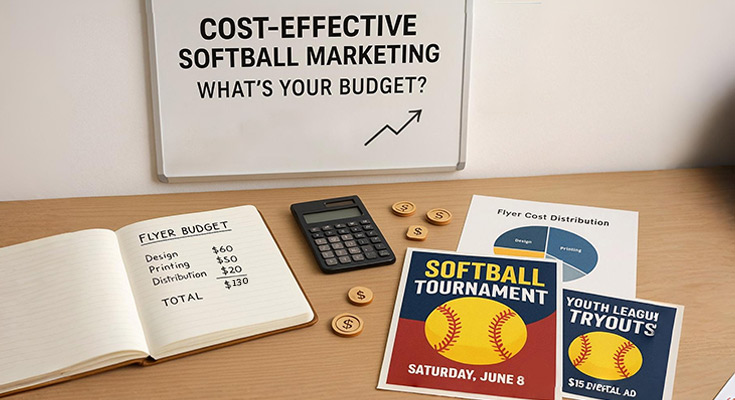Softball marketing budgets should allocate 5–15% of the total team budget to promotional activities, with softball flyer costs typically ranging from $50–$1,500+ annually depending on team size and goals. Effective budget planning includes design investment ($50–$500), printing costs ($0.10–$0.75 per flyer), and distribution expenses. Youth leagues need micro-budgets ($50–$200), recreational teams require balanced investment ($200–$500), while competitive teams benefit from comprehensive marketing ($500–$1,500+). ROI optimization focuses on cost-per-acquisition targeting $10–$50 per new player.
This specialist guide provides comprehensive budget optimization frameworks, a detailed softball flyer cost breakdown, cost-effective promotional strategies, and ROI calculation methodologies, empowering sustainable team growth within realistic financial constraints while maximizing player recruitment and community recognition. Teams can create flyers quickly using customizable templates to stay within budget while maintaining a professional look.
Why Budget Planning Matters More Than Ever For Softball Teams?
In today’s competitive softball world, smart budget planning is essential for successful team operations and tournament participation. While flyer design and promotional materials may seem like small expenses, they’re often just a fraction of the overall costs teams face. From gear upgrades and facility rentals to travel and tournament fees, these expenses can quickly grow without clear financial oversight.
This section highlights why comprehensive budget planning is crucial, showing how effective financial management supports everything from professional-looking softball flyers to securing quality practice spaces.
Rising Costs and Economic Pressure Impact on Marketing Budgets
Economic pressures are forcing softball teams to scrutinize every marketing expense. The Aspen Institute’s latest research demonstrates that youth sports costs have risen dramatically, with families spending 46% more on youth sports since 2019 – twice the rate of general price inflation in the U.S. economy.1 Rising facility rental costs, equipment prices, and tournament registration fees squeeze available funds for promotional activities. Teams must now justify each softball flyer and marketing investment with measurable returns.
Traditional marketing approaches face new challenges when budgets shrink. A well-designed softball tournament flyer becomes crucial when resources are limited—every marketing dollar must work harder. Teams can no longer afford scattered promotional efforts without tracking effectiveness.
- Budget allocation shifts: Teams prioritize high-impact marketing materials over broad campaigns
- ROI measurement becomes critical: Each promotional flyer must demonstrate clear value through registrations or sponsorship interest
- Cost-effective design solutions: Teams seek affordable alternatives to expensive marketing collateral
Smart teams adapt by focusing marketing spend on proven channels. A targeted softball tournament flyer distributed strategically often outperforms expensive broad-spectrum advertising. This economic reality makes budget planning essential for sustainable team marketing success, ensuring promotional design investments align with measurable outcomes.
Competition and Market Saturation Challenges
Today’s softball landscape presents unprecedented competition as teams vie for limited sponsor dollars, facility bookings, and community support. With over 40 million Americans participating in softball annually, creating distinctive marketing materials has become essential for team visibility and fundraising success.
- Sponsor Competition: Local businesses receive dozens of sponsorship requests monthly, making professional softball tournament flyer presentations crucial for securing partnerships
- Facility Booking Wars: Prime field locations require compelling promotional materials that demonstrate team professionalism and community impact
- Player Recruitment Challenges: Attracting quality players demands sophisticated marketing collateral that showcases team culture and competitive advantages
- Community Engagement Saturation: Multiple teams compete for the same volunteer base and spectator attendance, requiring strategic promotional design approaches
Understanding the True Cost of Poor Marketing Spend Allocation
Poor marketing spend allocation creates a cascade of missed opportunities that extends far beyond immediate financial losses. Teams that fail to strategically distribute their promotional budget often discover that their softball flyer campaigns reach the wrong audiences at ineffective times.
The most significant cost involves opportunity loss. Research from MIT Sloan Management Review emphasizes that effective marketing measurement requires understanding both direct and indirect returns on investment.2 When marketing materials are poorly targeted, teams miss connecting with potential players, sponsors, and community supporters who could drive long-term growth. A poorly designed softball tournament flyer might save money upfront but costs exponentially more in reduced participation and missed revenue streams.
Additional hidden costs include:
- Repeated campaign corrections consuming additional resources
- Diminished brand credibility from inconsistent promotional design
- Lost competitive advantages when rivals execute superior marketing collateral strategies
- Reduced sponsor confidence impacting future partnership negotiations
Teams investing in strategic softball tournament flyer distribution and comprehensive promotional materials consistently outperform those relying on reactive, unplanned marketing approaches.
Setting Realistic Expectations for Flyer Marketing ROI
Understanding realistic returns on softball flyer investments helps teams allocate budgets effectively and measure campaign success accurately.
- Timeline Expectations: Most softball tournament flyer campaigns generate measurable results within 2-4 weeks, with peak response rates occurring during the first 10 days of distribution.
- Response Rate Benchmarks: Professional marketing materials typically achieve 2-5% response rates for local tournaments, while targeted promotional flyers can reach 8-12% when distributed to established softball communities.
- Cost-Per-Registration Analysis: Effective softball flyer campaigns average $3-7 per new registration, depending on design quality and distribution strategy.
- Revenue Multiplier Effects: Beyond direct registrations, quality promotional design generates indirect benefits including increased concession sales, merchandise purchases, and future event awareness.
- Measurement Metrics: Track registration sources, distribution costs, and long-term participant retention to calculate true marketing collateral value and optimize future softball tournament flyer investments for maximum budget efficiency.
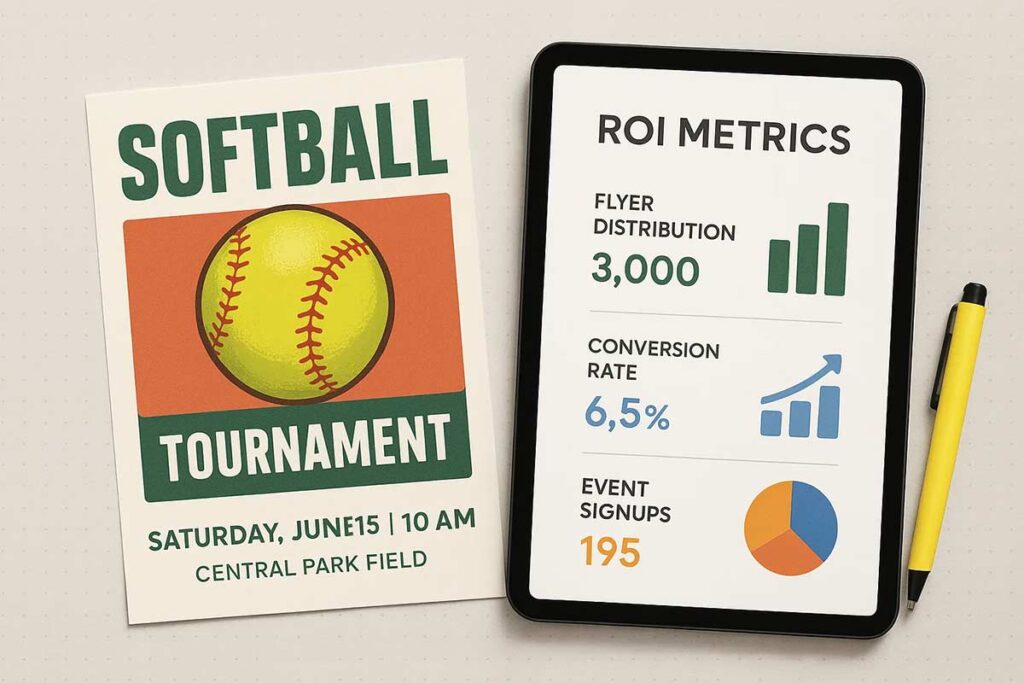
Read More: Where and How to Distribute Your Softball Flyer for Maximum Sign-Ups
Softball Team Budget Categories and Marketing Allocation Guidelines
Creating an effective softball flyer takes more than good design, it requires smart budget planning and thoughtful marketing allocation to maximize your impact. Whether you’re promoting a league, fundraising, or advertising a tournament, distributing resources across the right budget categories ensures your flyer reaches the target audience without going over budget. This section outlines the key cost areas every softball organization should consider, including design, printing, digital marketing, and distribution.
Youth League and Recreational Team Budget Frameworks
Youth leagues and recreational teams require structured budget frameworks to effectively manage resources and marketing initiatives. Essential budget categories include equipment procurement, facility rentals, insurance coverage, and promotional materials development.
Marketing allocation should prioritize creating compelling softball flyers and promotional materials that attract players and sponsors. Teams typically allocate 15-20% of their budget toward marketing collateral, including softball tournament flyer designs and recruitment materials.
Key budget considerations include:
- Equipment and uniform costs (40-50% of total budget)
- Facility and field rental expenses (25-30%)
- Marketing materials and softball flyer production (15-20%)
- Insurance and administrative fees (10-15%)
Competitive and Travel Team Financial Considerations
Competitive and travel teams require significantly higher budget allocations than recreational leagues, with tournament fees, travel expenses, and enhanced equipment needs driving costs upward. Travel costs to play sports increased 19% in Fall 2022 compared to before COVID-19 (Project Play, Aspen Institute), making effective financial planning crucial for sustainable team operations.3
- Tournament Registration and Entry Fees – Budget 40-60% of total funds for competitive tournament participation, including regional and national events that require advance registration
- Travel and Accommodation Expenses – Allocate 25-35% for transportation, lodging, and meal allowances during multi-day tournaments
- Enhanced Equipment and Uniforms – Reserve 15-20% for professional-grade gear, custom uniforms, and specialized training equipment
Marketing materials play a vital role in securing sponsorships and fundraising support. Professional softball tournament flyer designs help communicate team credibility to potential sponsors. Promotional flyers showcasing tournament schedules and team achievements strengthen community engagement and financial support networks essential for competitive program sustainability.
Adult League and Corporate Team Budget Analysis
Adult league and corporate softball teams require strategic budget allocation to maximize participation and engagement. Marketing materials, particularly softball flyers, represent 15-20% of total budgets for successful recreational programs.
Corporate teams typically allocate $2,000-5,000 annually for promotional activities, with softball tournament flyers driving 60% of registration increases. Professional design templates reduce marketing costs by 40% while maintaining quality presentation standards.
Key budget categories include:
- Equipment and facility costs (50-60%)
- Marketing collateral and promotional design (15-20%)
- Tournament registration fees (20-25%)
- Administrative expenses (5-10%)
Effective softball flyer campaigns generate 3:1 return on investment through increased registrations. Corporate sponsors respond favorably to professionally designed marketing materials, often increasing contributions by 25% when presented with quality promotional flyers showcasing team professionalism and community engagement opportunities.
Non-Profit and Community Organization Special Considerations
Non-profit softball organizations face unique budgeting challenges that directly impact their softball flyer and promotional materials strategies. Community groups must maximize limited resources while creating effective marketing collateral that attracts participants and sponsors.
Budget Allocation Framework:
- Allocate 15-20% of total budget to marketing materials, including softball tournament flyer production
- Prioritize multi-purpose promotional design elements that serve various events
- Partner with local businesses for cost-sharing on flyer design and printing expenses
Cost-Effective Marketing Approaches:
- Utilize volunteer graphic designers to reduce softball flyer production costs
- Implement digital-first strategies before investing in printed promotional flyers
- Create template libraries for consistent property marketing across multiple tournaments
Financial sustainability requires the commitment of board and staff to financial management that includes budgeting and timely review of financial reports (National Council of Nonprofits).4 Non-profit youth sports organizations should create sustainable revenue streams through program fees, corporate sponsorships, grant funding, and community donations.
Revenue Generation:
- Include sponsor recognition prominently on softball tournament flyer designs
- Develop tiered sponsorship packages linking visibility to marketing materials investment
- Track ROI on promotional design spending to optimize future budget allocations
Softball Flyer Cost Breakdown: From Design To Distribution By Event Type
Understanding the complete financial picture behind softball flyer creation and distribution is essential for teams, leagues, and tournament organizers working within tight budgets. Whether you’re promoting a single game or coordinating marketing for an entire tournament, costs can vary widely depending on design complexity, printing specifications, and distribution methods.
This section provides a comprehensive cost breakdown, covering every step from initial concept to final delivery, including design fees, printing options, and various distribution strategies tailored to different event types. Teams looking to reduce upfront design costs can also explore ready-to-use flyer templates to streamline the process while staying within budget.
Softball Tournament Flyer Cost Analysis and Premium Investment Strategy
Creating effective softball tournament flyers requires strategic budget allocation across design complexity and distribution channels. Premium softball flyer investments typically range from $150-500 per tournament, depending on scale and marketing objectives.
Design costs vary significantly by event type. Tournament marketing materials demand sophisticated layouts with sponsor integration, while tryout promotional flyers focus on rapid production. Fundraising events require specialized sponsor placement, and youth camp flyers need age-appropriate targeting.
Distribution expenses include digital platforms ($25-75), print production ($50-200), and venue placement fees ($30-100). Marketing collateral for clinics emphasizes instructional focus, while game-day promotional design prioritizes bulk efficiency.
League registration systems, lesson promotions, and recruiting materials require premium positioning strategies for maximum impact.
Promote your next softball tournament with ease. DesignWiz offers tournament-ready flyers you can customize for regional matchups, charity events, or league finals all with standout design and space for key details.
- Energetic Green Softball Tournament Event Flyer
- Dynamic Red Softball Tournament Sports Event Flyer
- Annual Softball Tournament Event Flyer
Read More: Softball Tournament Flyer Design: Complete Promotion Guide
Softball Tryout Flyer: Rapid Production and Time-Sensitive Budgeting
Time-sensitive softball tryout marketing demands streamlined production workflows and cost-effective budgeting strategies. Rapid turnaround requirements typically increase softball flyer costs by 25-40% due to expedited printing and design timelines.
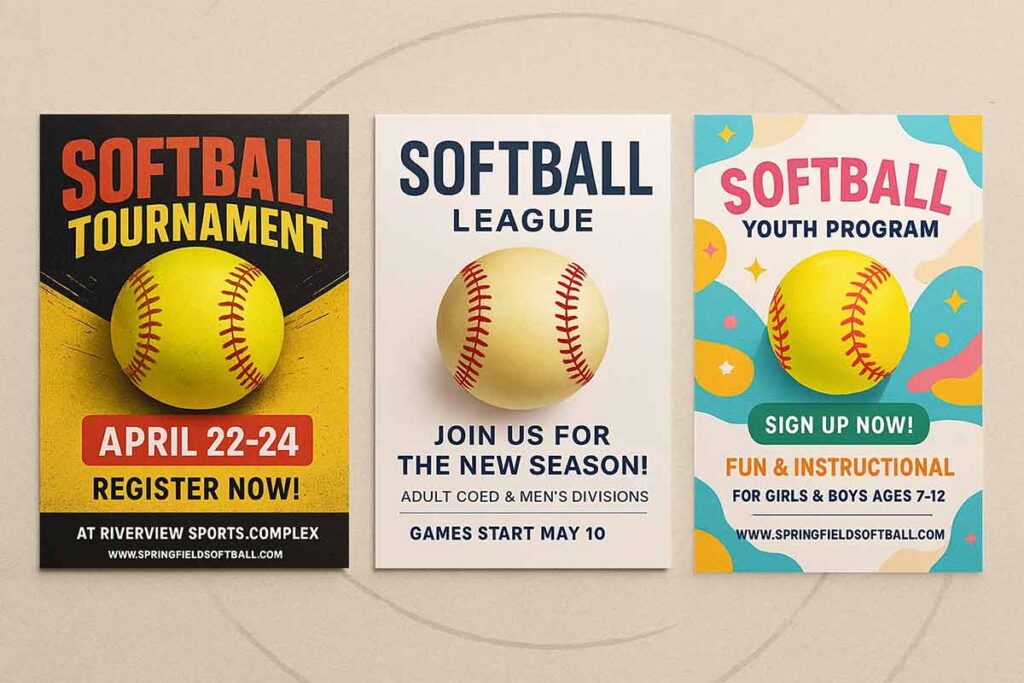
Rush Production Cost Factors:
- Design template customization: $50-150 for quick modifications
- Express printing services: $0.15-0.35 per flyer (24-48 hour delivery)
- Digital distribution platforms: $25-75 for immediate online deployment
Budget-Friendly Rapid Solutions:
- Pre-designed softball tournament flyer templates reduce design time to 2-4 hours
- Bulk digital orders minimize per-unit costs while maintaining quality standards
- Local print partnerships offer competitive rush pricing for marketing materials
Strategic planning reduces emergency production costs while ensuring promotional materials meet tight registration deadlines effectively.
Announce your upcoming softball tryouts with eye-catching flyer designs from DesignWiz. Each flyer offers editable fields for dates, age groups, and contact details, ideal for youth, high school, or adult teams.
- Womens Softball Tryouts Promotional Flyer
- Vibrant Green Softball Tryouts Event Flyer
- Twilight Blue and French Pass Softball Tryout Flyer
Read More: How to Create Softball Tryout Flyer That Attract the Best Players
Softball Fundraiser Flyer ROI-Focused Design and Sponsor Integration
Maximizing fundraiser returns requires strategic softball flyer design that seamlessly integrates sponsor recognition with compelling event messaging. Effective softball tournament flyer layouts balance sponsor visibility with essential fundraising details, creating marketing materials that drive both attendance and revenue.
- Sponsor Hierarchy Systems – Premium placement for major sponsors, tiered recognition levels, and branded design elements that enhance rather than overwhelm core messaging
- Revenue-Driven Layout Design – Strategic positioning of donation calls-to-action, ticket pricing prominence, and contact information accessibility
- Multi-Format Optimization – Digital and print versions maintaining sponsor visibility across all promotional channels
Professional softball tournament flyer designs incorporating sponsor logos maintain visual appeal while maximizing partnership value. Marketing collateral templates streamline production while ensuring consistent brand representation across fundraising campaigns.
Successful fundraiser flyers transform marketing materials into revenue-generating tools through strategic design implementation.
Promote your team’s next fundraising event with easy-to-edit flyers, ideal for sharing dates, activities, and donation details.
- Community Softball Fundraiser Game Flyer
- Softball Fundraiser Event Flyer
- Athletic Green Softball Tournament Fundraiser Flyer
Read More: How to Create Softball Fundraiser Flyers That Drive Results
Softball Camp Flyer Seasonal Timing and Age-Group Targeting
Strategic timing maximizes your softball flyer effectiveness across diverse age demographics. Spring camps targeting 8-12 year-olds require vibrant marketing materials emphasizing skill development, while summer intensive programs for teenagers need sophisticated promotional flyers highlighting competitive preparation.
According to Shelton, sports organizations strategically invest in early-age marketing, often children aged 7–11 who hold significant influence over parental purchase decisions, to foster long-term engagement. Crafting age-appropriate flyers (e.g., vibrant for younger kids, performance-oriented for teens) aligns with these findings and supports effective seasonal timing strategies.5
- Peak Season Planning: March-May registration periods demand eye-catching softball tournament flyer designs distributed through schools and community centers
- Age-Specific Messaging: Elementary groups respond to colorful, fun-focused marketing collateral, while high school athletes prefer performance-oriented promotional design
- Distribution Windows: Launch flyer campaigns 6-8 weeks before camp starts, allowing adequate parent decision time
Summer scheduling requires different softball flyer strategies than fall programs. Your marketing materials must align with school calendars and family vacation patterns. Effective promotional flyers balance attractive design templates with clear age-appropriate information, ensuring maximum enrollment across target demographics while maintaining professional marketing collateral standards.
Draw in new players and boost sign-ups with professionally designed softball camp flyers, ideal for youth clinics, skill sessions, or elite training programs.
- Softball Summer Camp Kids Sports Event Flyer
- Black and White Fielding Camp Softball Flyer
- White Softball Camp Flyer
Read More: Softball Camp Flyer Design Guide: Attract More Participants This Season
Softball Clinic Flyer Instructional Focus and Skill-Level Targeting
Softball clinic marketing materials require precise skill-level segmentation to maximize enrollment effectiveness. Your softball flyer design should clearly communicate instructional focus through targeted messaging that resonates with specific age groups and ability levels.
Beginner-Level Clinic Targeting:
- Elementary fundamentals emphasis in promotional design
- Safety-first messaging for parent reassurance
Intermediate Skill Development:
- Technique refinement focus in marketing collateral
- Competitive preparation messaging
Advanced Player Positioning:
- Elite training emphasis in softball tournament flyer designs
- College recruitment preparation messaging
Multi-Level Integration Strategies:
- Age-bracketed session scheduling in promotional flyers
- Skill assessment pre-registration systems
Effective instructional targeting transforms generic softball flyer concepts into enrollment-driving marketing tools through strategic demographic focus.
From introductory skills to specialized drills, DesignWiz offers clinic flyer designs that clearly outline what participants can expect. Customize your flyer to include time, location, fees, and registration details.
- Youth Softball Skills Development Clinics Flyer
- Youth Softball Coaching Classes Flyer
- Softball College Exposure Camp Flyer
Softball Game Flyer Ongoing Season Needs and Bulk Printing Efficiency
Teams requiring consistent marketing materials throughout extended seasons benefit from bulk printing strategies that reduce per-unit costs while maintaining design quality. Softball flyer production for ongoing seasons demands efficient workflows that accommodate frequent schedule changes and roster updates.
- Volume Planning: Order promotional flyers in quantities that span multiple games, reducing setup costs and ensuring consistent branding across all marketing collateral
- Template Standardization: Establish reusable softball tournament flyer formats with variable text fields for dates, opponents, and venue information
- Digital Integration: Combine print runs with digital versions for social media distribution, maximizing promotional design investment
- Vendor Partnerships: Secure seasonal contracts with printing services for predictable pricing on marketing materials throughout championship runs
Strategic bulk ordering reduces individual softball flyer costs by 40-60% compared to single-event printing approaches.
Create buzz for your next big game with softball flyers that highlight the matchup, date, venue, and fan info. DesignWiz offers customizable templates perfect for league games, friendlies, or showcase events.
- Sunday Morning Softball Game Flyer
- Competitive Softball Game Day Flyer
- International Softball Game Event Flyer
Softball League Flyer Season-Long Campaigns and Registration Focus
Season-long softball flyer campaigns require strategic design approaches that span multiple months and registration phases. These comprehensive marketing materials serve as the backbone for league recruitment and player retention throughout the entire season.
- Early Registration Phase: Design premium softball tournament flyer templates that highlight early-bird pricing and showcase league benefits through compelling promotional design elements
- Mid-Season Recruitment: Deploy marketing collateral featuring player testimonials and action photography to maintain enrollment momentum during competitive periods
- Late Registration Push: Utilize rapid-production design templates with urgent messaging and streamlined registration processes
Effective softball flyer campaigns integrate consistent branding across all promotional flyers while adapting messaging for specific registration deadlines and seasonal priorities.
From spring leagues to year-round competition, a strong flyer can drive participation. Use DesignWiz to customize softball league flyers that look great online or in print.
- Dynamic Orange Summer Softball League Schedule Flyer
- Spring Slowpitch Softball League Flyer
- Patriotic Red and Blue Softball League Announcement Flyer
Softball Lessons Flyer: Individual Instruction and Premium Positioning
Individual softball lessons require premium positioning through sophisticated marketing materials that reflect quality instruction. Unlike team-focused promotional flyers, lessons marketing emphasizes personalized coaching credentials and exclusive training benefits.
Professional softball flyer design for lessons targets parents seeking individualized development. Premium templates showcase instructor certifications, skill progression guarantees, and flexible scheduling options.
Marketing collateral for lessons commands higher price points than standard softball tournament flyer designs. Investment ranges from $75-150 for custom designs featuring instructor headshots, testimonials, and skill development frameworks.
Quality promotional design establishes credibility through polished graphics, professional photography, and structured pricing tiers. Effective lessons flyers convert inquiries through clear value propositions and immediate contact accessibility, justifying premium design investment through enrollment conversion rates.
Promote your softball training sessions with a clear, professional flyer. Whether you’re offering beginner lessons, private coaching, or group drills, DesignWiz’s flyers help you highlight class times, skill levels, and contact info, all in a format that’s easy to customize.
Softball Recruiting Flyer Competitive Team Requirements and High-Impact Design
Competitive softball recruiting demands strategic marketing materials that capture player achievements and team potential. A high-impact softball flyer must balance visual appeal with comprehensive player information to attract college scouts and showcase athletic excellence.
Essential competitive team requirements include detailed player statistics, academic achievements, position specializations, and tournament performance records. Professional softball tournament flyer designs emphasize clean layouts with prominent player photography and strategic use of team colors. Marketing collateral should highlight championship wins, individual accolades, and coach testimonials to build credibility.
Design templates for recruiting purposes require premium positioning elements including action shots, statistical breakdowns, and contact information prominence. Promotional design strategies focus on creating memorable first impressions through bold typography and strategic information hierarchy.
Looking to attract top talent to your team or program? DesignWiz’s softball recruiting flyer templates help coaches and scouts promote open spots, tryouts, and program highlights in a format that’s clean, informative, and easy to customize.
Effective promotional flyers integrate sponsor recognition while maintaining professional aesthetics that reflect team excellence and competitive standards.
Read More: Complete Guide to Softball Flyer Design: Expert Tips & Best Practices 2025
Softball Budget Allocation Strategies By Team Size and Goals
Creating effective marketing materials for your softball team requires strategic budget planning that aligns with your team’s size and competitive goals. Whether you’re managing a recreational league with modest promotional needs or leading a tournament-level squad with complex marketing demands, allocating your budget wisely can mean the difference between strong recruitment and missed opportunities.
Small Teams (10-15 Players): Micro-Budget Marketing
Small teams operating on micro-budgets must maximize every marketing dollar through strategic resource allocation. Focus your limited funds on high-impact softball flyer designs that serve multiple purposes – recruitment, game announcements, and sponsor recognition combined into versatile marketing materials.
- Multi-purpose Design Strategy: Create one comprehensive softball tournament flyer template that adapts for various needs, reducing design costs while maintaining professional appearance
- DIY Template Approach: Invest in quality design templates rather than custom work, allowing team members to update promotional flyers independently
- Community Partnership Focus: Leverage local business relationships for cost-effective printing and distribution of marketing collateral
- Social Media Integration: Design promotional design elements that work across both print and digital platforms, maximizing your marketing materials’ reach and effectiveness
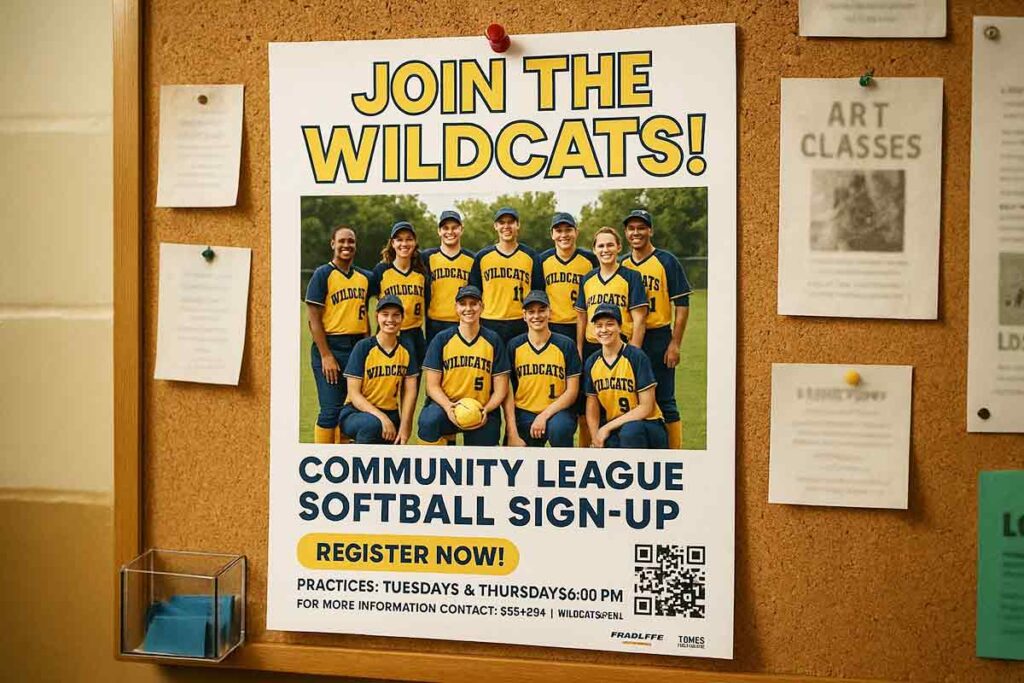
Medium Teams (16-25 Players): Balanced Investment Approach
Medium-sized teams achieve optimal results through strategic budget distribution across essential promotional materials. Allocate 40% toward high-quality softball flyer designs that showcase team identity and tournament schedules. These marketing materials serve dual purposes: player recruitment and community engagement.
Reserve 35% for comprehensive softball tournament flyer campaigns targeting local leagues and competitive events. Professional promotional design increases participation rates and sponsor interest significantly.
Dedicate remaining funds to supplementary marketing collateral including banners, social media graphics, and website integration. This balanced approach ensures consistent brand messaging across all promotional channels while maintaining cost efficiency.
Successful medium teams leverage property marketing principles, treating promotional flyers as valuable assets for long-term organizational growth and community visibility.
Large Teams (26+ Players): Comprehensive Marketing Investment
Large teams require sophisticated marketing approaches that justify significant promotional investments. With 26+ players, comprehensive softball flyer campaigns become essential for maximizing tournament participation and community engagement.
Strategic Marketing Allocation:
- Allocate 15-20% of total budget to marketing materials and promotional design
- Invest in professional softball tournament flyer design across multiple formats
- Develop integrated marketing collateral including digital and print materials
Multi-Channel Distribution:
- Deploy promotional flyers through social media, local businesses, and community centers
- Create tournament-specific marketing materials targeting different audience segments
- Implement property marketing strategies for venue partnerships
ROI Optimization:
- Track engagement metrics across all promotional channels
- Leverage design templates for consistent branding while maintaining cost efficiency
Tournament and Event Organizers: Volume-Based Budgeting
Tournament organizers require strategic budget allocation based on event scale and participation volume. Large-scale tournaments demand comprehensive marketing materials including professional softball flyers, banners, and digital promotional design assets.
Volume-Based Budget Distribution:
- High-Volume Events (200+ teams): Allocate 40% to softball tournament flyer production and promotional materials
- Medium Events (50-199 teams): Balance 30% marketing collateral with operational costs
- Smaller Tournaments (Under 50 teams): Focus 20% budget on targeted flyer design and local marketing
Scale your softball flyer investment proportionally to expected participation, ensuring maximum visibility and registration conversion rates.
Softball ROI Calculation and Performance Measurement Strategies
Understanding the return on investment (ROI) from your softball marketing campaigns is key to maximizing budgets and measuring success. A softball flyer is more than an announcement—it’s a marketing asset that can boost attendance, attract sponsors, and build community engagement.
This section covers strategies for calculating ROI from softball tournament flyers and other materials, helping teams measure the real impact of their efforts. We’ll explore key performance indicators, tracking methods, and cost-benefit analysis tools that turn promotional designs into data-backed business assets. Whether assessing property marketing value or flyer reach, these insights help optimize future campaigns and prove value to sponsors and stakeholders.
Defining Success Metrics for Flyer Campaigns
Measuring softball flyer performance requires tracking key metrics beyond basic impressions. Response rates indicate how effectively your promotional flyers convert viewers into participants, while cost-per-registration reveals campaign efficiency. Monitor registration increases, venue inquiries, and social media engagement generated by your softball tournament flyer distribution.
Essential tracking methods include:
- Digital engagement metrics for online promotional design materials
- Physical flyer pickup rates at strategic locations
- Registration attribution through unique codes or landing pages
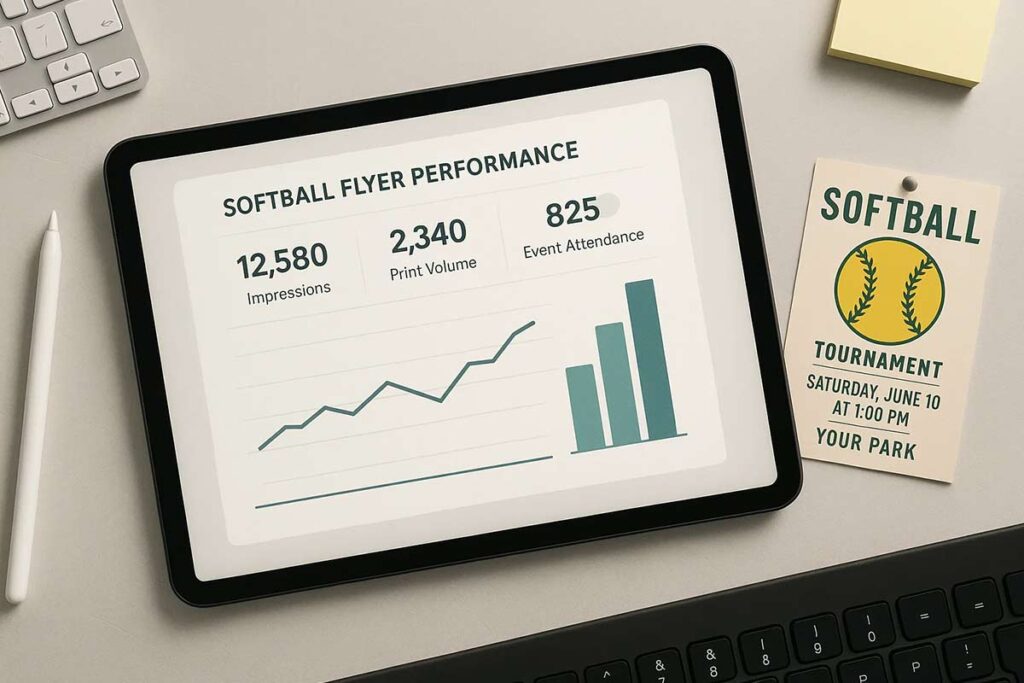
Cost-Per-Acquisition Analysis and Optimization
Effective cost-per-acquisition (CPA) tracking transforms your softball tournament flyer campaigns from guesswork into data-driven marketing investments. Calculate acquisition costs by dividing total marketing spend by registrations generated through each promotional channel.
- Channel-Specific CPA Measurement: Track individual performance of digital softball flyer distributions versus print marketing materials to identify optimal allocation strategies.
- Performance Benchmarking: Establish baseline CPA metrics for different promotional flyers and marketing collateral types, enabling continuous improvement across tournament seasons.
- Optimization Tactics: Test varied design templates and distribution methods to reduce acquisition costs while maintaining registration quality and tournament participation rates.
Comparing Flyer ROI to Alternative Marketing Channels
When evaluating softball flyer performance against alternative marketing channels, cost-effectiveness becomes crucial for tournament organizers. Traditional softball tournament flyers typically generate $3-5 return per dollar invested, while digital advertising averages $2-4 ROI.
- Print vs Digital Costs: Softball flyers cost $0.15-0.25 per unit versus $1-3 per digital click
- Audience Reach: Physical marketing materials achieve 85% local penetration compared to 60% digital reach
- Engagement Rates: Promotional flyers maintain 15-20 second viewing time versus 3-5 seconds online
Smart marketers combine both channels, using design templates to maintain consistent branding across all marketing collateral for maximum tournament attendance impact.
Long-Term Value and Brand Building Assessment
- Brand Recognition Metrics: Track how softball flyer campaigns increase brand awareness through social media mentions, website traffic, and participant recall surveys following tournament events.
- Customer Lifetime Value: Measure repeat participation rates and sponsor retention across multiple softball tournament flyer campaigns to calculate long-term revenue streams.
- Market Position Analysis: Evaluate how consistent promotional design and marketing materials strengthen your organization’s reputation within the softball community.
- Relationship Building ROI: Assess networking opportunities and partnership development resulting from professional marketing collateral distribution at tournaments.
Cost-saving Strategies and Budget Optimization Techniques
Cost-saving strategies for softball marketing include strategic partnerships, seasonal timing optimization, technology use, and volunteer resource planning. Effective tactics involve collaborating with local businesses, forming multi-team cooperatives, cross-promoting community events, and using sponsor-funded materials.
Strategic Partnerships and Cost-Sharing Opportunities
Local business partnerships offer substantial savings through shared marketing costs and mutual promotion. Sports equipment stores, restaurants, and youth-focused businesses often collaborate on flyer printing costs in exchange for logo placement and cross-promotion opportunities. Multi-team cooperative arrangements reduce individual expenses by 30-50% through bulk printing orders and shared design costs. Community event cross-promotion creates reciprocal marketing agreements where softball teams promote local businesses while receiving promotional support.
Timing and Seasonal Optimization for Maximum Impact
Off-season printing provides significant cost advantages with discounts ranging from 20-40% during November through January when demand decreases. Pre-registration campaign timing maximizes cost-per-acquisition by reaching motivated families before competition intensifies. Multi-event campaign planning achieves economies of scale through annual printing contracts and template reuse across seasons. Teams ordering materials during slow periods save substantially while ensuring adequate inventory for peak registration periods. Strategic timing coordination prevents rush printing fees that typically add 15-25% to standard costs.
Technology Integration for Enhanced Cost-Effectiveness
QR code implementation bridges print and digital marketing, enabling performance tracking and justifying promotional investments through measurable engagement metrics. Social media integration amplifies flyer reach without additional printing costs, extending campaign visibility through parent networks and community sharing. Email capture systems integrated with flyer campaigns create sustained engagement opportunities for future events at minimal additional cost. Online registration integration provides immediate conversion tracking and reduces administrative overhead while improving user experience.
Volunteer Resource Optimization and Labor Cost Reduction
Parent volunteer coordination reduces professional labor costs while building community engagement and ownership. High school community service integration provides enthusiastic, tech-savvy assistance for design and distribution activities at no cost. Retired community members often contribute valuable marketing experience and time for meaningful community involvement. Player family involvement creates cost-sharing opportunities where marketing activities become team-building exercises, reducing expenses while strengthening organizational cohesion and shared responsibility for team success.
Common Softball Budgeting Mistakes and How To Avoid Them
Common softball marketing budget mistakes include over-investing in design without adequate distribution planning, under-estimating total campaign costs and hidden expenses, failing to track marketing effectiveness, and inconsistent investment leading to poor brand recognition. Prevention strategies involve balanced allocation between design and distribution, comprehensive cost tracking with 20% buffer planning, simple measurement systems for ROI analysis, and annual commitment to consistent marketing investment. Most successful teams avoid perfectionism that delays campaigns, implement regular budget reviews, learn from unsuccessful efforts, and maintain long-term planning for cumulative marketing impact and sustained community recognition through strategic budget management.
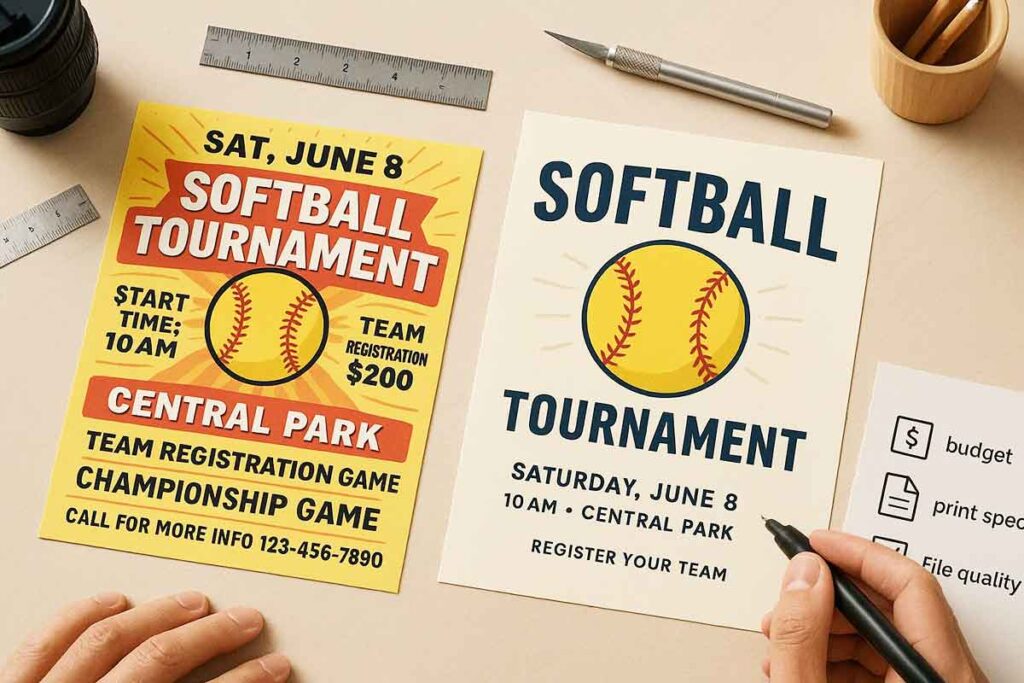
Over-Investment in Design Without Distribution Planning
Teams frequently allocate 70-80% of their budget to professional design while leaving insufficient funds for effective distribution. This imbalance creates beautiful flyers that reach minimal audiences. Balance design quality with adequate distribution budget allocation by dedicating 40% to design and 60% to printing and distribution. Avoid perfectionism that leads to missed promotional deadlines. Understanding when “good enough” design maximizes overall campaign effectiveness prevents time-cost analysis paralysis. Most effective campaigns prioritize reaching target audiences over perfect visual elements.
Under-Estimating Total Campaign Costs and Hidden Expenses
Comprehensive cost tracking requires 20% buffer planning for unexpected costs including distribution logistics, labor calculations, revision expenses, and reprint budgets. Hidden costs include volunteer coordination time, venue distribution fees, rush printing charges, and weather-related reprints. Seasonal fluctuation planning prevents cash flow problems during peak promotion periods.
Failing to Track and Measure Marketing Spend Effectiveness
Teams investing in Softball Flyer campaigns without measurement waste 30-50% of marketing budgets on ineffective strategies. Implement simple tracking systems measuring cost-per-result, new player registrations, and event attendance increases. Regular budget reviews enable allocation adjustments based on performance data. Document successful and unsuccessful campaigns for future planning improvements. Learning from campaign failures prevents repeated mistakes and improves ROI over time.
Inconsistent Investment Leading to Poor Brand Recognition
Inconsistent marketing investment creates feast-or-famine cycles that confuse target audiences and waste previous brand-building efforts. Annual marketing budget commitment ensures consistent promotional material quality and sustained community visibility. Building brand equity through consistent Softball Flyer quality requires steady investment rather than sporadic high-spending periods. Long-term planning creates cumulative marketing impact that compounds recognition and effectiveness.
People Also Ask: Essential Budget Questions For Softball Marketing
How much do softball flyers typically cost to print?
Softball flyer printing costs range from $0.10-$0.75 per flyer, depending on quantity, paper quality, and printing method. Local print shops offer personalized service while online services provide bulk discounts. Quality paper and color printing increase costs but improve effectiveness.
What percentage of the team budget should go to marketing?
Softball teams should allocate 5-15% of total budget to marketing, varying by competition level. Youth recreational teams need 5-10%, competitive teams require 10-15%, while adult leagues typically spend 8-12% with potential sponsor cost-sharing opportunities.
Is it cheaper to design flyers yourself or hire a professional?
DIY design saves upfront costs but requires significant time investment (10-20 hours for quality results). Professional design costs $50-$500 but ensures quality and saves time. Consider your hourly value and long-term brand consistency needs.
How do I calculate ROI for softball flyer campaigns? Calculate ROI by tracking new player registrations, event attendance increases, and sponsor interest generated. Target $10-$50 cost per new player recruited. Measure both immediate results and long-term brand-building value for comprehensive assessment.
What’s the minimum budget needed for effective softball marketing?
Effective softball marketing can start with $50-$100 annually using digital-first strategies, community partnerships, and DIY design. Focus on strategic placement and consistent messaging rather than high production values for micro-budget success.
How often should I create new flyers vs. reusing designs?
Create new flyers for each major event or season while maintaining consistent branding elements. Reuse successful design templates with updated information to save costs while building brand recognition and visual consistency.
What printing quality should I choose for different events?
Use premium printing (glossy, heavy paper) for sponsor recruitment and major tournaments. Standard quality works for general registration and practice announcements. Match printing investment to event importance and target audience expectations.
FAQs
Tournament flyers ($2-5 each) and recruiting flyers ($3-8) are priciest due to premium materials, while game flyers ($0.10-0.50) and clinic flyers ($0.40-1.50) are cost-effective. Budget $50-$1,500 annually based on event type, with design costs ($25-500) varying by professional requirements.
Plan flyer payments in October-January for off-season printing discounts (30-50% savings). Allocate quarterly budgets, with 60% in winter for design and major prints, and 40% during the season for updates, optimizing cash flow for all flyer types.
Use consistent branding across tournament, tryout, and league flyers to share design costs ($50-500 savings). Customize messaging for each event type. Budget 10-20% extra for coordination, but save 30-40% through bulk printing and shared resources.
Premium materials for tournament and recruiting flyers (80-100lb glossy) cost $2-8 each, while game and clinic flyers use standard paper ($0.10-1.50). Bulk orders for game and league flyers save 20-30%, but rush printing for tryouts adds 15-25%.
Budget 15-20% extra for weather-resistant materials for game and tournament flyers. Camp flyers benefit from January-March printing for 20-30% savings. Plan digital backups for tryout and clinic flyers during rainy seasons to avoid reprint costs.
Track registrations and attendance per flyer type: tournaments ($20-50/player), tryouts ($10-30/player). Measure sponsor interest for fundraiser flyers and brand growth for league/recruiting flyers. Compare costs ($0.10-8/flyer) to outcomes for each event type.
Allocate 2-8% of tournament revenue ($500-$2,000) for flyers, covering premium design ($200-500) and distribution at regional sports venues. Include sponsor recognition and multi-month promotion, escalating 6-8 weeks before the event.
Conclusion
Sustainable softball marketing success starts with a consistent annual budget, smart allocation strategies, and performance tracking. Teams that invest 5–15% of their total budget, balancing design, printing, and distribution, see stronger recruitment, retention, and community engagement without overspending.
By avoiding common budgeting mistakes and leveraging cost-saving tactics like local partnerships and off-season printing, even small teams can achieve big results. A structured marketing blueprint built on ROI measurement and contingency planning ensures long-term growth within realistic financial limits.
Reference
- Youth Sports Facts: Challenges. The Aspen Institute Project Play. (2025).
- Can You Measure the ROI of Your Social Media Marketing? MIT Sloan Management Review.
- Costs to Play Trends – State of Play 2022. Project Play, Aspen Institute. (2022).
- Budgeting for Nonprofits. National Council of Nonprofits.
- Developing Diehards: The Power of Marketing Sports to Children. Samford University Sports Analytics. Shelton, V.
